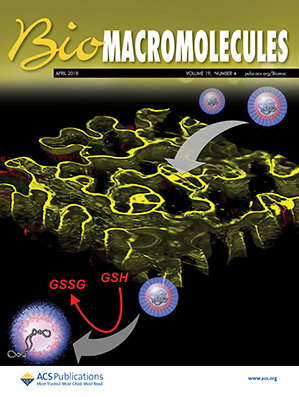nac -接枝活性氧清除聚合物纳米颗粒对急性肺损伤微环境的调节作用。
IF 5.4
2区 化学
Q1 BIOCHEMISTRY & MOLECULAR BIOLOGY
引用次数: 0
摘要
n -乙酰半胱氨酸(NAC)是通过其直接抗氧化能力增强急性肺损伤(ALI)防御的重要分子。然而,由于其生物利用度差和半衰期短,NAC的治疗用途受到限制。本研究将NAC接枝到由聚富马酸丙烯、聚硫酮和1,6-六亚甲基二异氰酸酯(PFTU)组成的聚氨酯上,以减少ALI中过度的氧化应激和炎症因子。制备了nac接枝的聚合物纳米颗粒(NPT@NPs)作为体外清除自由基和减轻炎症的给药系统。在脂多糖(LPS)诱导的ALI模型中,NPT@NPs在改善肺水肿、减少炎症细胞、抑制髓过氧化物酶表达、降低促炎细胞因子水平和逆转细胞凋亡方面表现出显著的疗效。NPT@NPs在减轻LPS对肺组织的有害作用方面明显优于游离NAC,从而对肺部炎症提供更有效的保护。本文章由计算机程序翻译,如有差异,请以英文原文为准。
NAC-Grafted ROS-Scavenging Polymer Nanoparticles for Modulation of Acute Lung Injury Microenvironment In Vivo
N-Acetyl cysteine (NAC) is an essential molecule that boosts acute lung injury (ALI) defense via its direct antioxidant capability. Nevertheless, the therapeutic use of NAC is limited due to its poor bioavailability and short half-life. In this study, NAC was grafted to the polyurethane consisting of poly(propylene fumarate), poly(thioketal), and 1,6-hexamethylene diisocyanate (PFTU) to reduce excessive oxidative stress and inflammatory factors in ALI. The NAC-grafted polymer nanoparticles (NPT@NPs) were prepared as a drug delivery system, which could effectively scavenge free radicals and reduce inflammation in vitro. The administration of NPT@NPs exhibited notable efficacy in ameliorating pulmonary edema, attenuating the presence of inflammatory cells, suppressing myeloperoxidase expression, diminishing the levels of pro-inflammatory cytokines, and reversing cell apoptosis in an ALI model induced by lipopolysaccharide (LPS). The NPT@NPs demonstrated significantly better efficacy compared to the free NAC in mitigating the deleterious effects of LPS on pulmonary tissue, thereby providing more effective protection against pulmonary inflammation.
- Download: Download high-res image (129KB)
- Download: Download full-size image
求助全文
通过发布文献求助,成功后即可免费获取论文全文。
去求助
来源期刊

Biomacromolecules
化学-高分子科学
CiteScore
10.60
自引率
4.80%
发文量
417
审稿时长
1.6 months
期刊介绍:
Biomacromolecules is a leading forum for the dissemination of cutting-edge research at the interface of polymer science and biology. Submissions to Biomacromolecules should contain strong elements of innovation in terms of macromolecular design, synthesis and characterization, or in the application of polymer materials to biology and medicine.
Topics covered by Biomacromolecules include, but are not exclusively limited to: sustainable polymers, polymers based on natural and renewable resources, degradable polymers, polymer conjugates, polymeric drugs, polymers in biocatalysis, biomacromolecular assembly, biomimetic polymers, polymer-biomineral hybrids, biomimetic-polymer processing, polymer recycling, bioactive polymer surfaces, original polymer design for biomedical applications such as immunotherapy, drug delivery, gene delivery, antimicrobial applications, diagnostic imaging and biosensing, polymers in tissue engineering and regenerative medicine, polymeric scaffolds and hydrogels for cell culture and delivery.
 求助内容:
求助内容: 应助结果提醒方式:
应助结果提醒方式:


